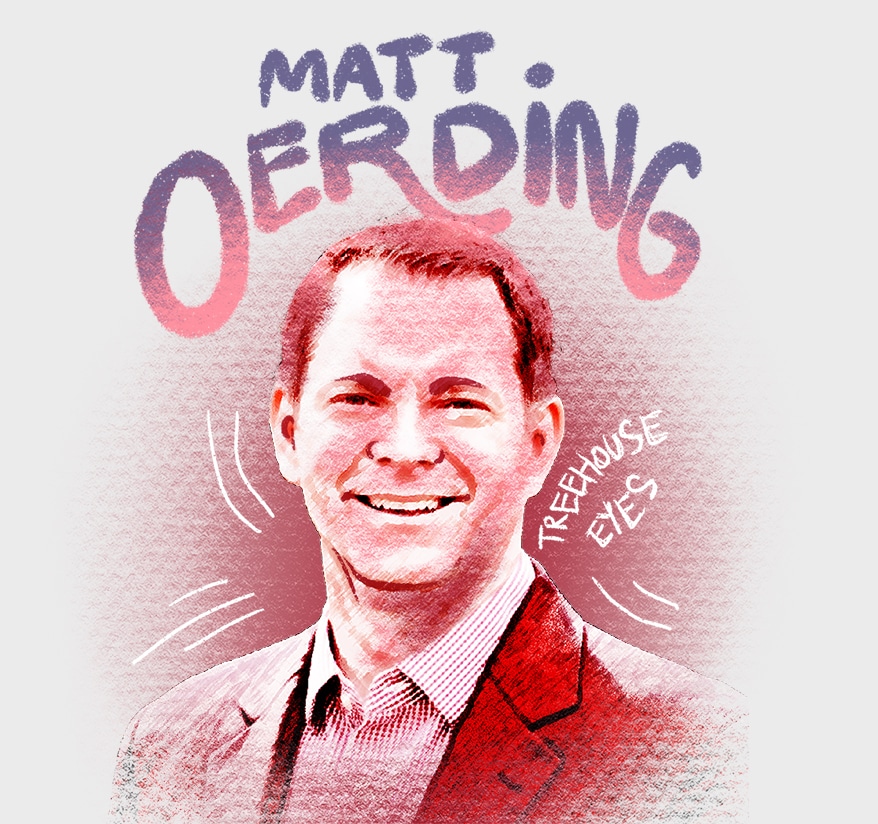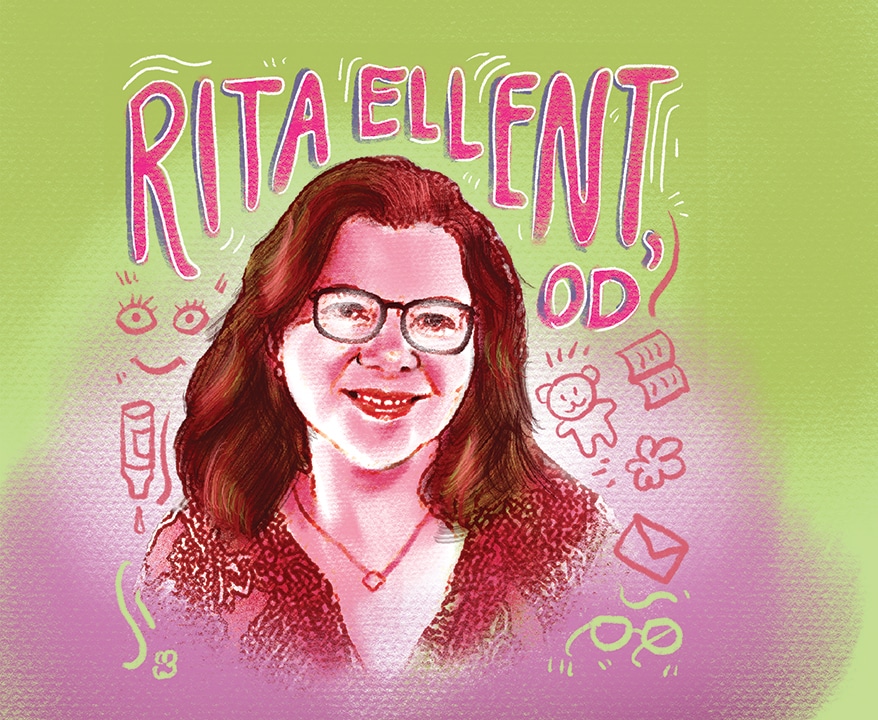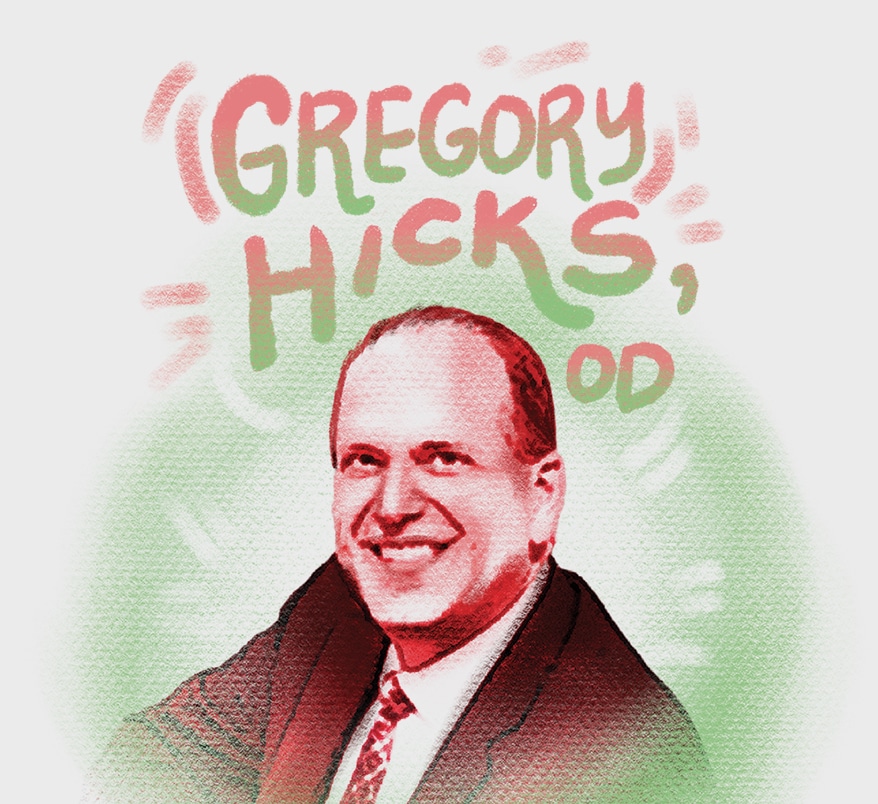While the reasons remain a subject of debate, the fact that childhood myopia is on the rise is borne out not only in statistical studies but also by what we’re hearing anecdotally from the exam lane. We won’t bombard you with stats here, though one that bears repeating is the World Council of Optometry’s (WCO) recent prediction that the prevalence of myopia worldwide will hit an astonishing 50% — that’s half the projected global population — by 2050.
Add to this the increasing availability of products and methods to control progression (the WCO in 2021 passed a resolution supporting myopia management as standard of care), and the question facing eyecare business owners becomes pretty obvious: Are you doing enough to tap this market and to reach kids that need this treatment?

According to Matt Oerding, co-founder of Treehouse Eyes, a pediatric specialty eyecare business focused on treating myopia that partners with independent practice owners, “We know about 30% of kids in the U.S. are myopic and only a very small fraction of those are in treatment. We believe the market eventually will be as big or bigger than orthodontic braces, which are worth over $15 billion annually in the U.S. The only question is how quickly do we get there and who dominates that space?”
Oerding adds that parent awareness of myopia treatment (versus correction) is still very low, “so it is critical to proactively offer these services.”
Of course, launching any specialty requires a genuine commitment. Myopia treatment requires a high degree of clinical skill — customizing a treatment plan for each child versus just limiting yourself to one treatment method. As Oerding puts it, “This is a specialty where ‘dabbling’ isn’t worth it.” Taking that warning on board, there’s no denying the rewards can be substantial, both for your bottom line and your patients. We spoke to five eye doctors who have implemented successful myopia control programs and asked them to share the key elements in that success. Their insights cover the gamut from the requisite tools of the trade to the necessary education resources and from marketing hacks to expected returns. Taken together they offer a vision of what a successful myopia management program looks like and demonstrate the rich benefits that launching one can bring to your eyecare business.

The Gardens Eye Care
Forest Hills, NY
“Offering our patients state-of-the-art vision care is one of the guiding principles of our practice since we opened our doors a decade ago,” says Dr. Rita Ellent, and specializing in myopia management (MM) is one of the ways The Gardens Eye Care does that. Since bringing in MM seven years ago, Ellent says, the specialty has grown to the point where it now contributes 35-40% of The Gardens Eye Care’s business, and she expects that contribution to grow by 5-10% per year over the next three years. She lists the most effective treatment plans used by her practice as:
Low-dose atropine sourced from a compounding pharmacy. “There are numerous around the country.”
Orthokeratology (ortho-k). “We work with multiple manufacturers to custom design the patients’ ortho-k’s based on specific patients’ needs, such as Contex, Paragon, Euclid, Eyespace.”
Daily wear myopia stabilizing contact lenses (MiSight, Natural Vue).
Myopia stabilization multifocal spectacle lenses.
Ellent believes it’s essential that a practitioner enjoy — as she always has —working with children to succeed in MM. “Expanding my practice to offer MM was just a natural transition for me.” When it comes to developing the necessary skill set, Ellent says a great place to start is joining the American Academy of Orthokeratolgy & Myopia Control. (See box on page 41 for more of Dr. Ellent’s top resources for MM providers.)
As for tools, she says the only truly essential piece of equipment is a corneal topographer, if a practitioner doesn’t already have one, adding that she has gotten good results with the Medmont Corneal Topographer. While The Gardens Eye Care’s office is quite small, they do have a Kids’ Space with a table, chairs, books and toys. All in all, Ellent does not feel that MM ortho-k requires a significant cost outlay.
Advertisement
One beautiful aspect of MM and ortho-k, she says, is that they lie outside the scope of vision savings plans, so there’s no coding/billing of managed vision plans involved. “This allows staff resources to focus on proving exceptional patient care.”
Ellent feels the most effective way to get the MM word out is to start from within. “I see many kids in our practice, so whenever I finish examining a child that is a good candidate for MM I always discuss the options the parents have to preserve their childs’ eye health. Patients are coming to us for our professional opinions so it’s crucial we take the time out of a busy day to have these conversations with families.”
Sending out e-blasts to patients has been an effective way to market the services from within the practice base, she adds.
Unsurprisingly, the team at The Gardens spend a significant amount of time educating patients and parents in-office on proper care and hygiene techniques, reinforcing this information with take-home material. Says Ellent, “I give all my ortho-k families my direct cell and they can reach me anytime.
If there is an issue or concern with one of my ortho-k kids I want to be the first to know about it and help them manage it most effectively.”

Lifetime Optometric
Fresno, CA
Lifetime Optometric has seen revenue from its MM services rise steadily, including a sharp increase of 110% from 2021 to 2022. “We have had new patients seeking our services for myopia control because their current optometrist doesn’t offer it,” says Dr. Staci Hamamoto.
Currently Dr. Hamamoto manages all of Lifetime’s myopia control patients, with referrals coming from practice owner Dr. Margie Recalde. “It’s important that both staff and doctors support their doctors’ specialty services,” she says. The practice offers three MM options — ortho-k (or CRT), MiSight contact lenses, and atropine eye drops. She provided INVISION with an extensive list of the resources that are available to help both doctors and team members stay on top of advancements in the field (see page 41).
About a year ago Lifetime purchased a machine that measures axial length of the eye and recently began using it to pre-test all young patients scheduled for an eye exam. “It will help raise awareness about myopia to our patients which will help open the discussion about new ways to manage it for years to come.”
Aside from this the outlay has been modest, Hamamoto reports. Educational materials for parents such as brochures and posters are provided by vendors Paragon CRT and MiSight. About $200 was spent on a kids’ table and decorations, toys and goodies, though these have been removed post-COVID so there are no ongoing expenses there. This supports the view of Treehouse Eyes’ Oerding that, “The great news about myopia treatment is it doesn’t require an investment in inventory, you just need the right equipment and time to execute with staff. For equipment, you need an optical biometer to get axial length measurements. You may want some upfront investments in improving your website presence if it is a bit dated as this is where parents will find you.”
Hamamoto advises eyecare businesses to first establish fees for all myopia services including consultations, new patients, established patients, and annual follow-up care, then train staff on how to provide a price quote up front. Offering the three options gives the practice the flexibility to adjust to different budgets, which helps alleviate parent objections, she says. “Since services are primarily out of pocket and vision and medical plans cannot be used, we offer financing through Sunbit and Care Credit to help patients do payments over time.”
To enhance compliance, she recommends creating MM agreement forms to communicate with both parents and the child to emphasize the importance of following the treatment plan. It is explained that contact lens companies have a warranty period for fitting lenses and will not allow returns/exchanges outside the period.
Current patients are kept aware of the program through emails, and Lifetime also posts on social media to highlight services and summer specials. For this, they hired a marketing company that posts on all platforms. “We’ve also used Facebook ads and Google ads. Your marketing company can give you options on how much to spend,” she says, adding that summer vacation is the best time to market myopia services so they invest extra funds to start marketing in May.
Hamamoto stresses the importance of updating your website to highlight myopia control. “Write a blog specific about myopia control and post it. The contact lens companies are great resources to provide content,” she says, adding that Lifetime has gained many new patients because of Google. “They Google ‘ortho-k’ and our office shows up on the list for their area.”

Premier Eyecare
Knoxville, TN
D r. Brent Fry and his team at Premier Eyecare had been treating patients with ortho-k and multifocal contact lenses for “off label” MM for years but saw a dramatic increase in patients enrolling in the program after they began offering MM options to all myopic patients under the age of 18. “When we first started our MM program a few years ago, we educated the doctors and staff members through webinars and staff training meetings in order to establish our practice as placing an emphasis on treating and managing myopia as a disease rather than just a refractive disorder,” says Fry.
Of the treatment options offered by the practice — ortho-k, multi-focal contact lenses, and low-dose atropine — most patients choose ortho-k, which Fry attributes to “the wow factor of ortho-k and the fact that parents don’t need to buy glasses for their children.”
When discussing MM with patients and parents, staff hand out a custom brochure describing the three main options (MiSight is favored for the multifocal CL option). They also discuss the fee schedule and make parents aware that most vision plans do not recognize MM as a treatment option and therefore the fees will be out-of-pocket. The practice is also happy to help them navigate their particular plan in order to take full advantage of their benefits.
The team is careful to make sure parents know the benefits of the treatments as well as the importance of compliance. “We have found that most of our children are very compliant with our treatment programs, but guidance early on from parents is crucial in developing good habits,” says Fry.
Not being a pediatric-specific practice, Premier Eyecare hasn’t felt the need to alter its office physically with the arrival of the MM program, though the children’s section of the optical features a kid’s corner outfitted with bean bags and a television.
Once they decided to get serious about MM, Premier Eye Care purchased an IOL Master to complement the corneal topographer, which he agrees is crucial in managing ortho-k. “The doctors in our practice have attended multiple lectures online and have read many articles and studies on MM and are constantly evaluating our procedure based on the latest research,” says Fry. “We owe it to our patients to be the experts they need.”
Advertisement
Fry says fees need to be high enough to make the investment in equipment and staff training sustainable. “Just like professional fees for contact lenses, myopia management fees should be thoroughly thought out to provide value to the patient and to the practice.”
Marketing begins in the exam lane, he says. “We have found that verbally discussing MM with every patient and their parents when myopia is first diagnosed is crucial.” Staff hand a brochure to the parent of any child diagnosed with myopia, and also mention the program to adult patients with high myopia to ensure they are aware in case they have children that may benefit from the program. This has created a greater awareness among patients of the importance of starting eyecare for children at an early age, Fry says. But ultimately, he adds “Even if the parents of our young myopes do not enroll their child in the program, they are appreciative of the information and our concern and willingness to stay on the cutting edge of our profession.”

Little Eyes Pediatric Eye Care
Carmel, IN
A decade ago, Little Eyes went all in and decided to open a pediatric only primary care practice, a move that has turned out be “well worth it,” according to Dr. Katherine Schuetz. Little Eyes has developed a loyal customer base and receives many outside Rx’s in its dispensary, creating serious education opportunities for myopia control. The practice has fully embraced the specialty, which now contributes about 20% of its business, up from zero at opening.
“We started with ortho-k within two to three years of opening our pediatric office and have grown in both MM and amount of patients every year,” says Schuetz, adding that enrolling patients in MM keeps them with the practice longer, boosting growth.
When it comes to getting the word out, she says, “Word of mouth has been the absolute best marketing for us. We certainly have good information about MM on our website, and reviews from happy parents, but just doing our job well has made many families tout our praises to their friends which has brought in the most outside MM patients.”
It’s a view endorsed by Oerding of Treehouse Eyes, who says “The best return on investment [booster] is simply talking to every parent that comes into your practice about it, just like dentists start talking about braces when your child is 7 or 8 years old. When we work with practices at Treehouse Eyes, we focus first on internal processes to educate and close, then start more external marketing to drive new patients in.” But he adds a note of caution: “Don’t drive new patients before you know how to execute; it will be a waste of money.”
It helps that at Little Eyes the whole office vibe is kid friendly. “Parents feel comfortable bringing their child somewhere created with their child in mind,” Schuetz says. “There’s a level of trust that we’re the experts in pediatrics, so parents are more likely to respond well to our treatment recommendations.”
Schuetz says it’s important to stay on top of the latest data and techniques. “Constantly update yourself on the evolution of MM, and then be able to communicate that information in a clear way to help parents understand and accept your treatment plan.” She also advises investing in a great topographer and optical biometer, as well as staff training for optimal results for both your patients and practice.
The most important thing, in her view, is to mentally commit to spending the time required to keep pace with the advancements in this fast-changing field, “whether it’s during slow time as you’re building your practice or in your free time after a busy day of patients.” She also recommends joining forums where myopia control is discussed and new research presented. “If you slack, you are hurting your patient base.”

Family Eye Care Centers
Sandusky, OH
U nlike some of the other business owners we spoke to, Dr. Gregory Hicks does not explicitly market his myopia treatment as a program. “I have promoted myself as a pediatric optometrist with an emphasis on vision and child development. This has proven to be a successful practice builder,” he says. Dr. Hicks outlined for us the forms of myopia treatment he provides, listing their pros and cons in terms of compliance, acceptance by parents, ease of administration to patients, and profitability.
In Hicks’ experience, MM using contact lenses is the most popular option with parents. Rigid ortho-k lenses are clearly effective in slowing progression, he says, and while this method is more expensive, it has been nothing less than “a practice builder” for him. “It is more expensive for the family, requires more time in the office and requires a lot of parent education. However, many families with a myopic child have numerous myopic children — and these families tell other families.” Fitting these lenses requires a much higher skill level than other contact lenses; accordingly, Hicks charges much higher fees for this service. He reels off a list of positives: “Lots of support available from the lens manufacturers; since these are only worn at night all of the care, use, and handling is done at home; no need for the child to take the lenses from the home; treatment zone is on the eye 24/7; and no glasses or lenses needed during the day, which is a big plus, especially for sports.”
Recent years have seen the introduction of daily disposable multifocal contacts. These are more costly for the family but take much less in-office time, says Hicks, adding that in his experience parents embrace them readily. Among the pros of this method is the plentiful manufacturer support ODs can expect, both in terms of training how to fit as well as educating parents. “This has been profitable for the office and is an easy program to administer.” Referring to both options, “It certainly helps if parents are contact lens wearers,” he says.
According to Hicks, low dose atropine is easy to administer, takes very little time, is effective and relatively inexpensive. However, he says, “I find a high amount of parental push back and this takes lots of discussion. This has become a little easier now with so much on the internet about myopia for parents to review.”
Advertisement
Hicks also manages children’s myopia by treating binocular vision problems. This often involves a combination of both spectacle multifocal contact lenses and both “in office” and “at home” vision therapy. “This is a much more intense and expensive treatment option for both the family and practice. It requires a much more concentrated effort and investment.”
He says the various combinations of spectacle lens designs he has used have not been as effective, but there are some promising designs on the horizon.
Hoya Vision Care (where he served as director of professional affairs for 14 years) has what he calls “a proven lens design called Miyosmart which significantly reduces myopia progression and eye elongation. It is not yet available in the U.S. but is being used extensively and successfully in other countries.”
Dr. Hicks’ list of issues to be discussed with parents of myopic children:
- Less screen time
- Less near point activity
- More outdoor play time
- UV protection
- Blue light reduction
- Impact of sleep
- Consistent bedtime
- Nutrition